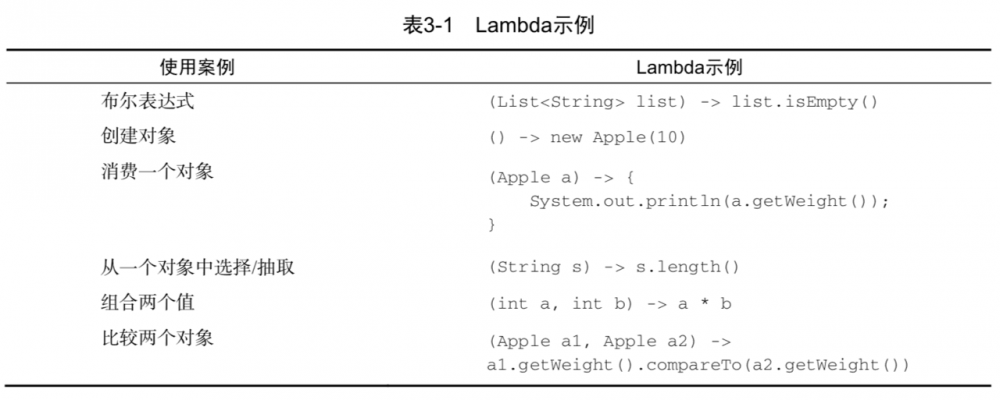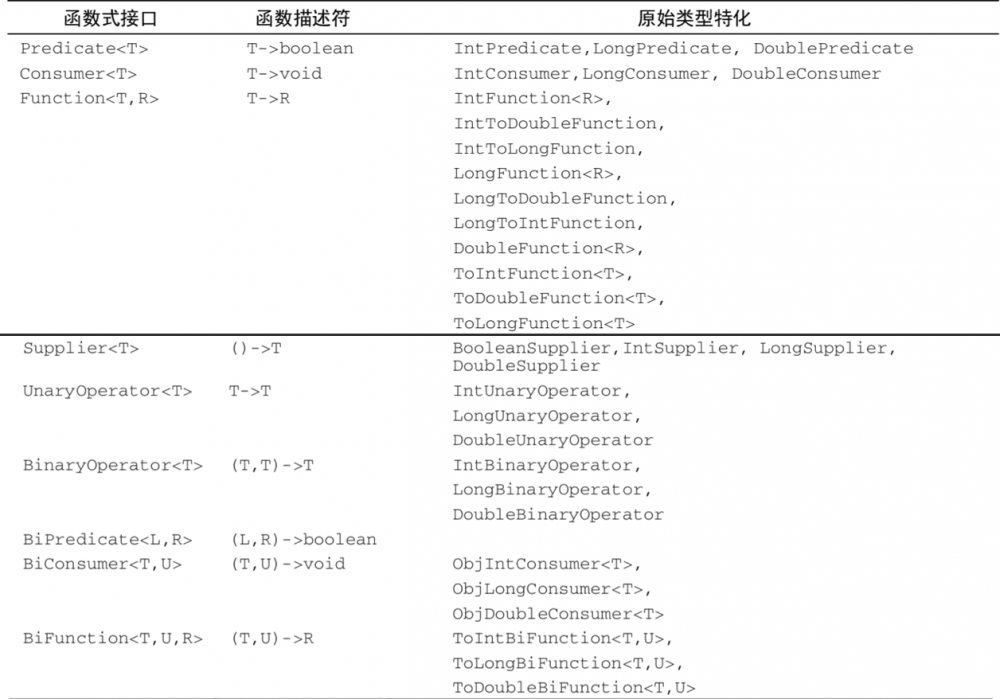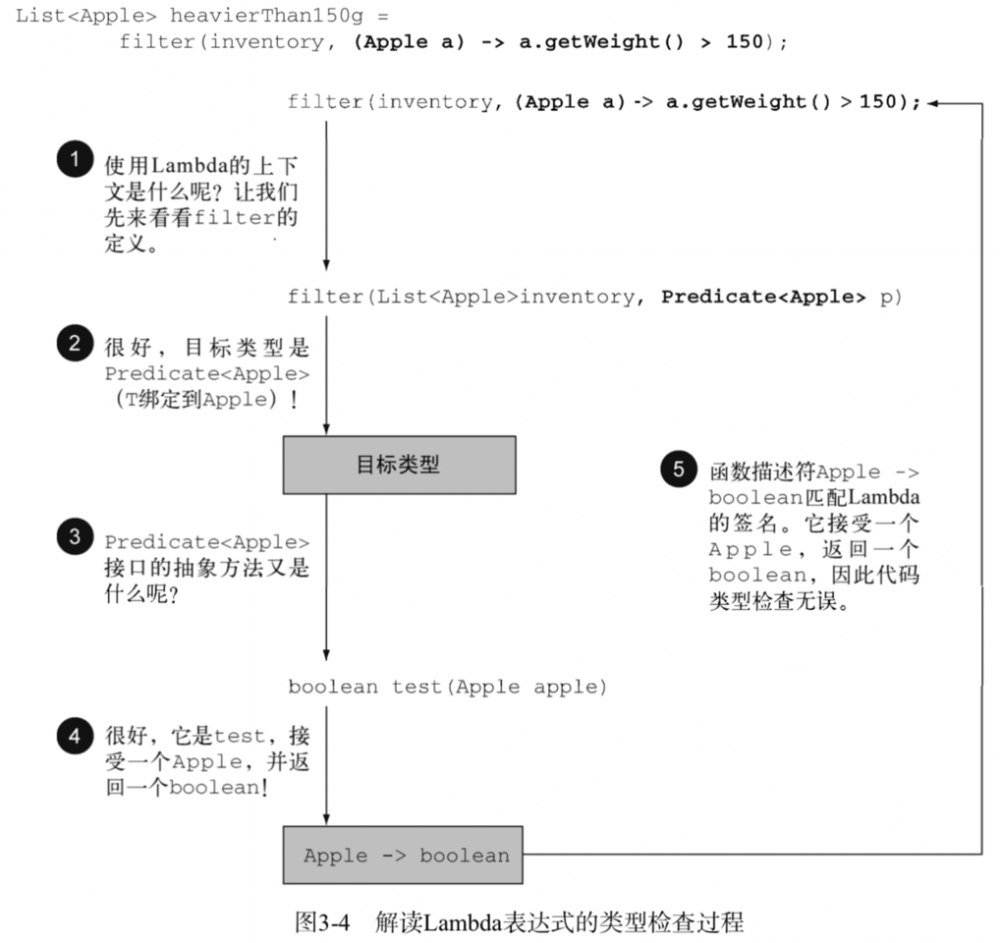《Java 8 in Action》Chapter 3:Lambda表达式
可以把Lambda表达式理解为简洁地表示可传递的匿名函数的一种方式:它没有名称,但它有参数列表、函数主体、返回类型,可能还有一个可以抛出的异常列表。
- 匿名——我们说匿名,是因为它不像普通的方法那样有一个明确的名称:写得少而想得多!
- 函数——我们说它是函数,是因为Lambda函数不像方法那样属于某个特定的类。但和方法一样,Lambda有参数列表、函数主体、返回类型,还可能有可以抛出的异常列表。
- 传递——Lambda表达式可以作为参数传递给方法或存储在变量中。
- 简洁——无需像匿名类那样写很多模板代码。
2. Lambda写法
(parameters) -> expression 或 (parameters) -> { statements; } eg:(Apple a1, Apple a2) -> a1.getWeight().compareTo(a2.getWeight()); Lambda表达式有三个部分:
- 参数列表——这里它采用了Comparator中compare方法的参数,两个Apple。
- 箭头——箭头->把参数列表与Lambda主体分隔开。
- Lambda主体——比较两个Apple的重量。表达式就是Lambda的返回值了。

3. 函数式接口和函数描述符
函数式接口就是只定义一个抽象方法的接口。接口上标有 @FunctionalInterface 表示该接口会设计成 一个函数式接口,如果你用 @FunctionalInterface 定义了一个接口,而它却不是函数式接口的话,编译器将返回一个提示原因的错误。接口现在还可以拥有默认方法(即在类没有对方法进行实现时, 其主体为方法提供默认实现的方法)。哪怕有很多默认方法,只要接口只定义了一个抽象方法,它就仍然是一个函数式接口。
函数式接口的抽象方法的签名就是Lambda表达式的签名。我们将这种抽象方法叫作:函数描述符。例如,Runnable接口可以看作一个什么也不接受什么也不返回(void)的函数的签名,因为它只有一个叫作run的抽象方法,这个方法什么也不接受,什么也不返回(void)。
4. 三种常用的函数式接口
4.1 Predicate
/**
* Represents a predicate (boolean-valued function) of one argument.
* <p>This is a <a href="package-summary.html">functional interface</a>
* whose functional method is {@link #test(Object)}.
* @param <T> the type of the input to the predicate
* @since 1.8
*/
@FunctionalInterface
public interface Predicate<T> {
/**
* Evaluates this predicate on the given argument.
* @param t the input argument
* @return {@code true} if the input argument matches the predicate,
* otherwise {@code false}
*/
boolean test(T t);
}
复制代码
Predicate的英文示意是:谓词。 Predicate接口定义了一个名叫test的抽象方法,它接受泛型T对象,并返回一个boolean。
4.2 Consumer
/**
* Represents an operation that accepts a single input argument and returns no
* result. Unlike most other functional interfaces, {@code Consumer} is expected
* to operate via side-effects.
* <p>This is a <a href="package-summary.html">functional interface</a>
* whose functional method is {@link #accept(Object)}.
* @param <T> the type of the input to the operation
* @since 1.8
*/
@FunctionalInterface
public interface Consumer<T> {
/**
* Performs this operation on the given argument.
* @param t the input argument
*/
void accept(T t);
}
复制代码
Consumer的英文示意是:消费者。 Consumer接口定义了一个名叫accept的抽象方法,它接受泛型T对象,并没有返回任何值。
4.3 Function
/**
* Represents a function that accepts one argument and produces a result.
* <p>This is a <a href="package-summary.html">functional interface</a>
* whose functional method is {@link #apply(Object)}.
* @param <T> the type of the input to the function
* @param <R> the type of the result of the function
* @since 1.8
*/
@FunctionalInterface
public interface Function<T, R> {
/**
* Applies this function to the given argument.
* @param t the function argument
* @return the function result
*/
R apply(T t);
}
复制代码
Function的英文示意是:功能。 Function接口定义了一个名叫apply的抽象方法,它接受泛型T对象,并返回一个泛型R的对象。
Java还有一个自动装箱机制来帮助程序员执行这一任务:装箱和拆箱操作是自动完成的。但这在性能方面是要付出代价的。装箱后的值本质上就是把原始类型包裹起来,并保存在堆里。因此,装箱后的值需要更多的内存,并需要额外的内存搜索来获取被包裹的原始值。Java 8为我们前面所说的函数式接口带来了一个专门的版本,以便在输入和输出都是原始类型时避免自动装箱的操作。
4.4 Java 8中的常用函数式接口

5. 类型检查、类型推断以及限制
5.1 类型检查
Lambda的类型是从使用Lambda的上下文推断出来的。上下文(比如,接受它传递的方法的参数,或接受它的值的局部变量)中Lambda表达式需要的类型称为目标类型。

类型检查过程可以分解为如下所示。
- 首先,你要找出filter方法的声明。
- 第二,要求它是Predicate(目标类型)对象的第二个正式参数。
- 第三,Predicate是一个函数式接口,定义了一个叫作test的抽象方法。
- 第四,test方法描述了一个函数描述符,它可以接受一个Apple,并返回一个boolean.
- 最后,filter的任何实际参数都必须匹配这个要求。
这段代码是有效的,因为我们所传递的Lambda表达式也同样接受Apple为参数,并返回一个 boolean。请注意,如果Lambda表达式抛出一个异常,那么抽象方法所声明的throws语句也必 须与之匹配。有了目标类型的概念,同一个Lambda表达式就可以与不同的函数式接口联系起来,只要它 们的抽象方法签名能够兼容。比如,前面提到的Callable和PrivilegedAction,这两个接口都代表着什么也不接受且返回一个泛型T的函数。 因此,下面两个赋值是有效的:
Callable<Integer> c = () -> 42; PrivilegedAction<Integer> p = () -> 42; 复制代码
特殊的void兼容规则 如果一个Lambda的主体是一个语句表达式, 它就和一个返回void的函数描述符兼容(当然需要参数列表也兼容)。 例如,以下两行都是合法的,尽管List的add方法返回了一个 boolean,而不是Consumer上下文(T -> void)所要求的void:
// Predicate返回了一个boolean Predicate<String> p = s -> list.add(s); // Consumer返回了一个void Consumer<String> b = s -> list.add(s); 复制代码
5.2 类型推断
Java编译器会从上下文(目标类型)推断出用什么函数式接 口来配合Lambda表达式,这意味着它也可以推断出适合Lambda的签名,因为函数描述符可以通过目标类型来得到。这样做的好处在于,编译器可以了解Lambda表达式的参数类型,这样就可以在Lambda语法中省去标注参数类型。
// 没有类 型推断 Comparator<Apple> c = (Apple a1, Apple a2) -> a1.getWeight().compareTo(a2.getWeight()); // 有类型推断 Comparator<Apple> c = (a1, a2) -> a1.getWeight().compareTo(a2.getWeight()); 复制代码
5.3 使用局部变量
Lambda表达式 也允许使用自由变量(不是参数,而是在外层作用域中定义的变量),就像匿名类一样。 它们被 称作捕获Lambda。 Lambda捕获的局部变量必须显式声明为final, 或事实上是final。换句话说,Lambda表达式只能捕获指派给它们的局部变量一次。
- 第一,实例变量和局部变量背后的实现有一 个关键不同。实例变量都存储在堆中,而局部变量则保存在栈上。如果Lambda可以直接访问局部变量,而且Lambda是在一个线程中使用的,则使用Lambda的线程,可能会在分配该变量的线程将这个变量收回之后,去访问该变量。因此,Java在访问自由局部变量时,实际上是在访问它的副本,而不是访问原始变量。如果局部变量仅仅赋值一次那就没有什么区别了——因此就有了这个限制。
- 第二,这一限制不鼓励你使用改变外部变量的典型命令式编程模式(我们会在以后的各章中 解释,这种模式会阻碍很容易做到的并行处理)。
6. 方法引用
方法引用可以被看作仅仅调用特定方法的Lambda的一种快捷 写法,方法引用看作针对仅仅涉及单一方法的Lambda的语法糖。目标引用放在分隔符::前,方法的名称放在后面。方法引用主要有三类:
- (1) 指向静态方法的方法引用(例如Integer的parseInt方法,写作Integer::parseInt)。
- (2) 指向任意类型实例方法的方法引用(例如String的length方法,写作 String::length)。
- (3) 指向现有对象的实例方法的方法引用(假设你有一个局部变量expensiveTransaction 用于存放Transaction类型的对象,它支持实例方法getValue,那么你就可以写expensive- Transaction::getValue)。
对于一个现有构造函数,你可以利用它的名称和关键字new来创建它的一个引用: ClassName::new。它的功能与指向静态方法的引用类似。
Supplier<Apple> c1 = Apple::new;
Apple a1 = c1.get();
这就等价于:
Supplier<Apple> c1 = () -> new Apple(); // 利用默认构造函数创建 Apple的Lambda表达式
Apple a1 = c1.get(); // 调用Supplier的get方法 将产生一个新的Apple
复制代码
7. 复合Lambda表达式的有用方法
7.1 比较器复合
Comparator<Apple> c = Comparator.comparing(Apple::getWeight);
// 逆序 按重量递 减排序
inventory.sort(comparing(Apple::getWeight).reversed());
// 比较器链 按重量递减排序;两个苹果一样重时,进一步按国家排序
inventory.sort(comparing(Apple::getWeight)
.reversed()
.thenComparing(Apple::getCountry));
复制代码
7.2 谓词复合
// 产生现有Predicate 对象redApple的非
Predicate<Apple> notRedApple = redApple.negate();
// 链接两个谓词来生成另 一个Predicate对象 一个苹果既是红色又比较重
Predicate<Apple> redAndHeavyApple = redApple.and(a -> a.getWeight() > 150);
// 链接Predicate的方法来构造更复杂Predicate对象 表达要么是重(150克以上)的红苹果,要么是绿苹果
Predicate<Apple> redAndHeavyAppleOrGreen = redApple.and(a -> a.getWeight() > 150)
.or(a -> "green".equals(a.getColor()));
请注意,and和or方法是按照在表达式链中的位置,从左向右确定优 先级的。因此,a.or(b).and(c)可以看作(a || b) && c。
复制代码
7.3 函数复合
andThen方法会返回一个函数,它先对输入应用一个给定函数,再对输出应用另一个函数。 比如, Function<Integer, Integer> f = x -> x + 1; Function<Integer, Integer> g = x -> x * 2; Function<Integer, Integer> h = f.andThen(g); int result = h.apply(1); 数学上会写作g(f(x))或(g o f)(x) 这将返回4 compose方法,先把给定的函数用作compose的参数里面给的那个函 数,然后再把函数本身用于结果。 Function<Integer, Integer> f = x -> x + 1; Function<Integer, Integer> g = x -> x * 2; Function<Integer, Integer> h = f.compose(g); int result = h.apply(1); 数学上会写作f(g(x))或(f o g)(x) 这将返回3 复制代码
8. 小结
以下是你应从本章中学到的关键概念。
- Lambda表达式可以理解为一种匿名函数:它没有名称,但有参数列表、函数主体、返回类型,可能还有一个可以抛出的异常的列表。
- Lambda表达式让你可以简洁地传递代码。
- 函数式接口就是仅仅声明了一个抽象方法的接口。
- 只有在接受函数式接口的地方才可以使用Lambda表达式。
- Lambda表达式允许你直接内联,为函数式接口的抽象方法提供实现,并且将整个表达式作为函数式接口的一个实例。
- Java 8自带一些常用的函数式接口,放在java.util.function包里,包括Predicate、Function<T,R>、Supplier、Consumer和BinaryOperator,如表3-2所述。
- 为了避免装箱操作,对Predicate和Function<T, R>等通用函数式接口的原始类型特化:IntPredicate、IntToLongFunction等。
- 环绕执行模式(即在方法所必需的代码中间,你需要执行点儿什么操作,比如资源分配 和清理)可以配合Lambda提高灵活性和可重用性。
- Lambda表达式所需要代表的类型称为目标类型。
- 方法引用让你重复使用现有的方法实现并直接传递它们。
- Comparator、Predicate和Function等函数式接口都有几个可以用来结合Lambda表达式的默认方法。
Tips
本文同步发表在公众号,欢迎大家关注!:grin: 各位大佬点点广告,万分感谢!!!后续笔记欢迎关注获取第一时间更新!












![[HBLOG]公众号](https://www.liuhaihua.cn/img/qrcode_gzh.jpg)

